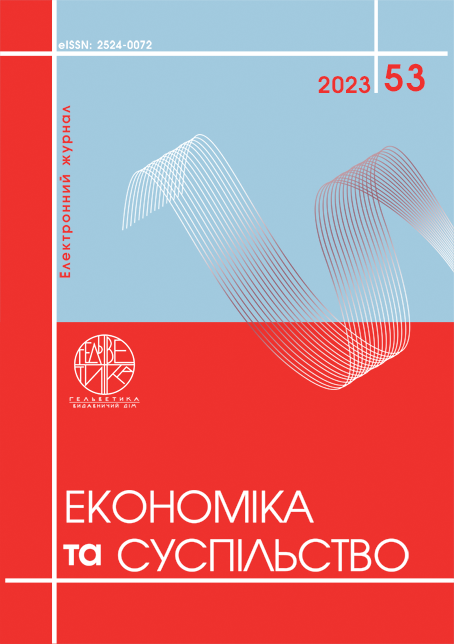STUDY OF THE METHOD OF AUDIT OF PRODUCTION STOCK AT THE ENTERPRISE
Abstract
The article is devoted to the study of the methodology of conducting an audit of production stocks to improve the management of stocks and production processes at enterprises. The author argues that inefficient inventory management can lead to financial losses and supply issues. Inventory auditing is presented as a necessary tool for assessing and ensuring effective management of these resources. The article emphasizes that advancements in technology, changes in business processes, and international accounting standards create a need for improved audit methods and evaluation of inventory management effectiveness. The author highlights the existence of various approaches to inventory audit methodologies, indicating the need for further research in this field. The aim of the article is to explore these audit methods and their effectiveness in enhancing inventory management and optimizing production processes. The article takes into account recent research in this area and provides recommendations for further investigations. Each proposed methodology is shown to be effective for inventory auditing, although the specific effectiveness of each method depends on various factors. These factors include ownership structure, legal form, operating conditions, level of development, business type, taxation system, software, and the effectiveness of internal control systems. To successfully conduct inventory audits, auditors need to consider these factors and have access to documentation related to inventory accounting and movement. The organization of the audit process includes steps such as planning, studying accounting policies, evaluating internal control systems, and analyzing financial reports related to inventories. Adhering to these steps diligently contributes to achieving the objectives of the audit and obtaining reliable results. Furthermore, studying the accounting policy document and verifying financial indicators help auditors understand the organization of inventory accounting and movement within a company and ensure their compliance with established standards and requirements. Effective adaptation of recommendations and methodologies to the specific needs and conditions of each enterprise will contribute to the efficiency of the audit process and the accuracy of financial reporting.
References
Кулаковська Л.П., Піча Ю.В. Організація і методика аудиту : підручник. Київ : Каравела, 2012. 544 с.
Мельнікова К.С. Напрями удосконалення методів і процедур аудиту виробничих запасів на прикладі макаронної фабрики. Економічні студії. 2014. № 1. С. 13–18. DOI: https://doi.org/10.36477/2522-1205-2022-70-13
Огійчук М.Ф., Рагуліна. І.І., Новіков І.Т. Аудит : навчальний посібник. 4-те вид., перероб. і допов. Київ : Алерта, 2020. 852с.
Положення (стандарт) бухгалтерського обліку 9 «Запаси»: наказ Міністерства фінансів України від 20 жовтня 1999 р. № 246, з наступними змінами. URL: http://zakon0.rada.gov.ua/laws/show/z0751-99
Сиротюк Г., Сиротюк К. Методичні особливості аудиту виробничих запасів. Вісник Львівського національного аграрного університету. Серія «Економіка АПК». 2015. № 22(1). С. 92–97.
Скорба О. А. Методика аудиту виробничих запасів. Dny vědy-2014: materiály X mezinárodní vědecko-praktická conference (Praha, 27 brezen-05 dubna 2014 r.). Praha, 2014. S. 58–60.
Скрипник М.І., Григоревська О.О., Радіонова Н.Й. Удосконалення організації і методики аудиту виробничих запасів на підприємстві. Проблеми теорії та методології бухгалтерського обліку, контролю і аналізу. 2016. № 2-3 (35). С. 378–398.
Утенкова К.О. Аудит : навчальний посібник. Київ : Алерта, 2011. 408 с.
Kulakovska L.P., Picha Yu.V. (2012). Orhanizatsiia i metodyka audytu: pidruchnyk [Organization and methods of audit: a textbook]. Kyiv: Karavela, 544 p. [in Ukrainian]
Melnikova K.S. (2014). Napriamy udoskonalennia metodiv i protsedur audytu vyrobnychykh zapasiv na prykladi makaronnoi fabryky [Directions for improving methods and procedures for auditing inventory on the example of a pasta factory]. Ekonomichni studii – Economic studies, 1, 13–18. DOI: https://doi.org/10.36477/2522-1205-2022-70-13 [in Ukrainian]
Oghijchuk M.F., Raghulina I.I., Novikov I.T. (2020). Audyt: navchalnyi posibnyk. 4-te vyd., pererob. i dopov [Audit: a textbook. 4th edition, revised and supplemented]. Kyiv: Alerta, 664 р. [in Ukrainian]
Polozhennia (standart) bukhhalterskoho obliku 9 «Zapasy»: nakaz Ministerstva finansiv Ukrainy vid 20 zhovtnia 1999 r. № 246, z nastupnymy zminamy. [Accounting Regulation (Standard) 9 "Inventories"]. Availabe at: http://zakon0.rada.gov.ua/laws/show/z0751-99 [in Ukrainian]
Syrotiuk H., Syrotiuk K. (2015). Metodychni osoblyvosti audytu vyrobnychykh zapasiv [Methodological features of inventory audit]. Visnyk Lvivskoho natsionalnoho ahrarnoho universytetu – Journal of Lviv National Agrarian University, 22(1), 92–97. [in Ukrainian]
Skorba O.A. (2014). Metodyka audytu vyrobnychykh zapasiv [Methodology for auditing inventory]. Materiály X mezinárodní vědecko-praktická konference «Dny vědy-2014» – Materials X International Scientific and Practical Conference "Days of Science-2014"(Prague, 27 March-05 April 2014), (pp. 58–60).
Skrypnyk M.I., Hryhorevska O.O., Radionova N.Y. (2016). Udoskonalennia orhanizatsii i metodyky audytu vyrobnychykh zapasiv na pidpryiemstvi [Improving the organization and methodology of auditing inventory at an enterprise]. Problemy teorii ta metodolohii bukhhalterskoho obliku, kontroliu i analizu – Problems of theory and methodology of accounting, control and analysis, 2-3 (35), 378–398. [in Ukrainian]
Utenkova K.O. (2011). Audyt: navchalnyi posibnyk [Audit: a textbook]. Kyiv: Alerta, 408 p. [in Ukrainian]

This work is licensed under a Creative Commons Attribution 4.0 International License.


